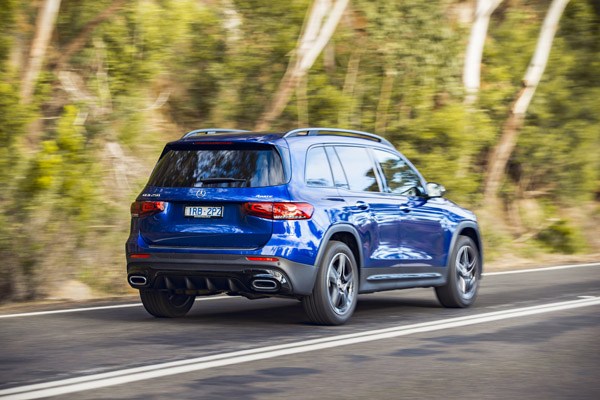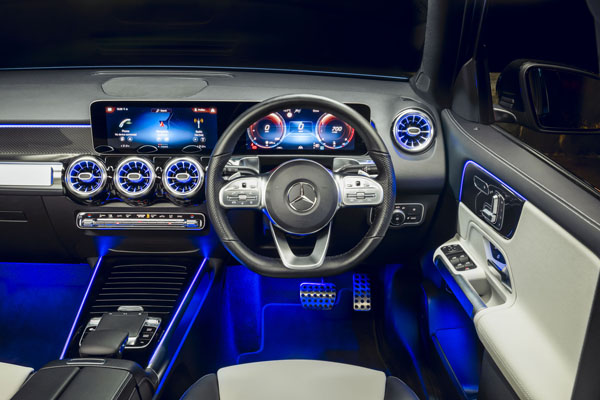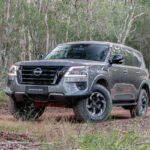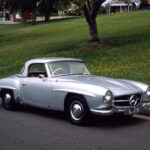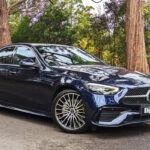 Until today, a seven-seater compact sports utility vehicle was a something of contradiction in terms. Typically, it has been left to an automobile manufacturer of Mercedes-Benz stature to disprove this.
Until today, a seven-seater compact sports utility vehicle was a something of contradiction in terms. Typically, it has been left to an automobile manufacturer of Mercedes-Benz stature to disprove this.
So, what brought on the challenge to Benz designers and engineers to breed this unique beast?
Britta Seeger, member of the board of management of Daimler AG responsible for Mercedes car sales, says every third Mercedes-Benz is an SUV, every fourth a compact car, so a compact SUV such as the GLB has all the genes of the two highest-volume segments.
The GLB-Class has three variants for Australia – the GLB 200 1.3 automatic; GLB 250 2.0 4Matic and GLB 35 4Matic, with two turbocharged petrol engines and an eight-speed dual-clutch automatic transmission.
Both the Mercedes-Benz GLB 200 and GLB 250 4Matic are on sale now. The GLB 200 is priced at $59,900, plus on-road costs, the GLB 250 4Matic $73,900. The Mercedes-AMG GLB 35 4 Matic will be priced at $88,900 when it arrives in Australia later this year.
STYLING
In these days of compact coupe / sports utility crossover vehicles, styles have regularly veered on the side of the swoopy coupe rather than the muscular workhorse.
Now, the Mercedes-Benz has put paid to this with its broad-shouldered, square-jawed pocket Atlas, the GLB-Class, which while classed as a small vehicle can carry up to seven adults.
The square looking GLB won’t win any beauty contests but a bold front, with classic Benz SUV sports grille and its large three-pointed star, gives the vehicle a no-nonsense nature fitting for a versatile family wagon. The profile does nothing to negate this.
INTERIOR
Décor is basic black with metallic highlights on dashboard and doors. Dominating the former is the screen of twin 10.25-inch displays combining instruments and multi-media information. It’s all stylish and well thought out.
The test car’s seating for up to seven occupants was a different matter, the black leather upholstery broken up by hideous white panels staring out from the base and back of each position.
The three rows offered wide-ranging standards of comfort and convenience. The middle bench does not tumble forward for easy access to the third row. Limited leg room makes for a knees-up sitting position, while head room is good, the latter no doubt due to the high-set rear-roof section – no swoopy roof.
Cargo capacity, with the 50 / 50 third row seats folded flat is a most usable 565 litres, which can be boosted to an expansive 1780 litres with the 40 / 20 / 40 split-fold second row also done away with. With six or seven occupants load space is seriously constrained.
On the other hand, loading from the rear is a breeze, with auto liftgate, low lip, and flat floor, four tie-down points, two bag hooks, a side storage net and a 12V power outlet.
INFOTAINMENT
Access to information is via the twin 10.5-inch touchscreen or touchpad, combined with hand rest, on the centre console, the latter highly sensitive to touch and not the easiest thing to control.
The innovative Mercedes-Benz MBUX (Mercedes-Benz User Experience) multimedia system takes centre stage, through its wide screen and voice activation with the phrase: Hey, Mercedes! Unfortunately, the charming female voice butted in to the cabin conversation whenever the word ‘Mercedes’ was mentioned.
The test vehicle boasted a premium Burmester surround sound system and ambient lighting with interchangeable colours.
All models in the GLB range can be registered with Mercedes-me Connect, the app that can control vehicle functions and features from a compatible smartphone.
ENGINES / TRANSMISSIONS
The Mercedes-Benz GLB 250 is powered by a 2-litre four-cylinder turbocharged petrol engine, mated with an eight-speed automatic transmission and, the maker’s 4Matic all-wheel drive system.
Power from the 165 kW 2.0-litre engine peaks up range at 5500rpm but maximum torque (350 Nm) is on hand at 1800rpm.
SAFETY
ANCAP awarded the GLBs a top five-star safety rating last year. Standard equipment includes nine airbags (dual front, front-side, curtain and rear-side plus driver’s knee), anti-skid brakes, electronic brake-force distribution and electronic stability and traction control.
Advanced driver-assist systems take in autonomous emergency braking with pedestrian and cyclist detection, lane-keep assist, blind-spot monitoring, rear cross-traffic alert, traffic sign recognition, driver attention alert, tyre pressure monitoring, hill-descent control, hill-start assist, high-beam assist, park assist, a reversing camera and front and rear parking sensors.
Front cross-traffic alert, steering assist and adaptive cruise control, sadly, are part of the optional $1990 Driving Assistance Package.
DRIVING
Well-weighted steering and pliant ride, gives the car a responsive character. Sport mode adds unexpectedly well to the SUV drive experience.
Mercedes puts the average combined urban / highway cycle fuel consumption at 7.7 litres per 100 kilometres, which compares with 11.1 and 6.1, respectively, with the test GLB 250.
One minor drawback with the DCT was the tendency to hesitate engaging ‘reverse’ from ‘park’ on an incline, causing the car to roll.
Early intervention lane-keep assist and autonomous emergency braking systems were straight out of Queensland Premier Annastacia Palasczcuk border strategy playbook. Get in hard and fast. It’s mildly annoying, but it is safety first, I suppose.
Three rows of seating offered wide-ranging standards of comfort and convenience. The middle bench does not tumble forward for easy access to the third row. Limited leg room makes for a knees-up sitting position, while head room is good, the latter no doubt due to the high-set rear-roof section.
The third row has two drink holders between the seats, as well as two outboard stowage compartments, each fitted with a USB port. When folded, the two seats stow flush with the load compartment floor to maximise cargo capacity.
Further flexibility is added by second-row seats that can be slid fore and aft by 140 mm, and a seat-back that splits 40:20:40. A multi-stage backrest ensures second-row passengers can get comfortable.
Getting out of the vehicle is enhanced by door skirting which stops legs or trousers picking up dirt from the side steps. Nice touch.
SUMMING UP
For those prepared to pay the price ($73k+) to be an early adopter of a seven-seat compact SUV, the Mercedes GLB 250 could be just the job. There are cheaper rivals but the level of technology and trim in them cannot compare.
AT A GLANCE
MODEL RANGE
Mercedes-Benz GLB 200 1.3 automatic $59,900
Mercedes-Benz GLB 250 2.0 4Matic $73,535
Mercedes-Benz GLB 35 4Matic $88,900
Note: These prices do not include government or dealer delivery charges. Contact your local Mercedes-Benz dealer for drive-away prices.
SPECIFICATIONS (Mercedes-Benz GLB 250 2-litre 4cyl turbocharged petrol, 8sp automatic, 4Matic, 7-seat SUV)
ENGINE:
Capacity: 1.991 litres
Configuration: Four cylinders inline
Maximum Power: 165 kW @ 5500-6100 rpm
Maximum Torque: 350 Nm @ 1800-4000 rpm
Fuel Type: 95 RON unleaded petrol
Combined Fuel Cycle (ADR 81/02): 7.7 L/100km
DRIVELINE: Eight-speed automatic, 4Matic
DIMENSIONS, WEIGHT AND CAPACITIES:
Length: 4638 mm
Wheelbase: 2829 mm
Width: 1834 mm
Height: 1659 mm
Turning Circle: N/A
Kerb Mass: 1766 kg
Fuel Tank Capacity: 60 litres
BRAKES:
Front: Ventilated disc
Rear: Disc
STANDARD WARRANTY:
Five years / unlimited kilometres




